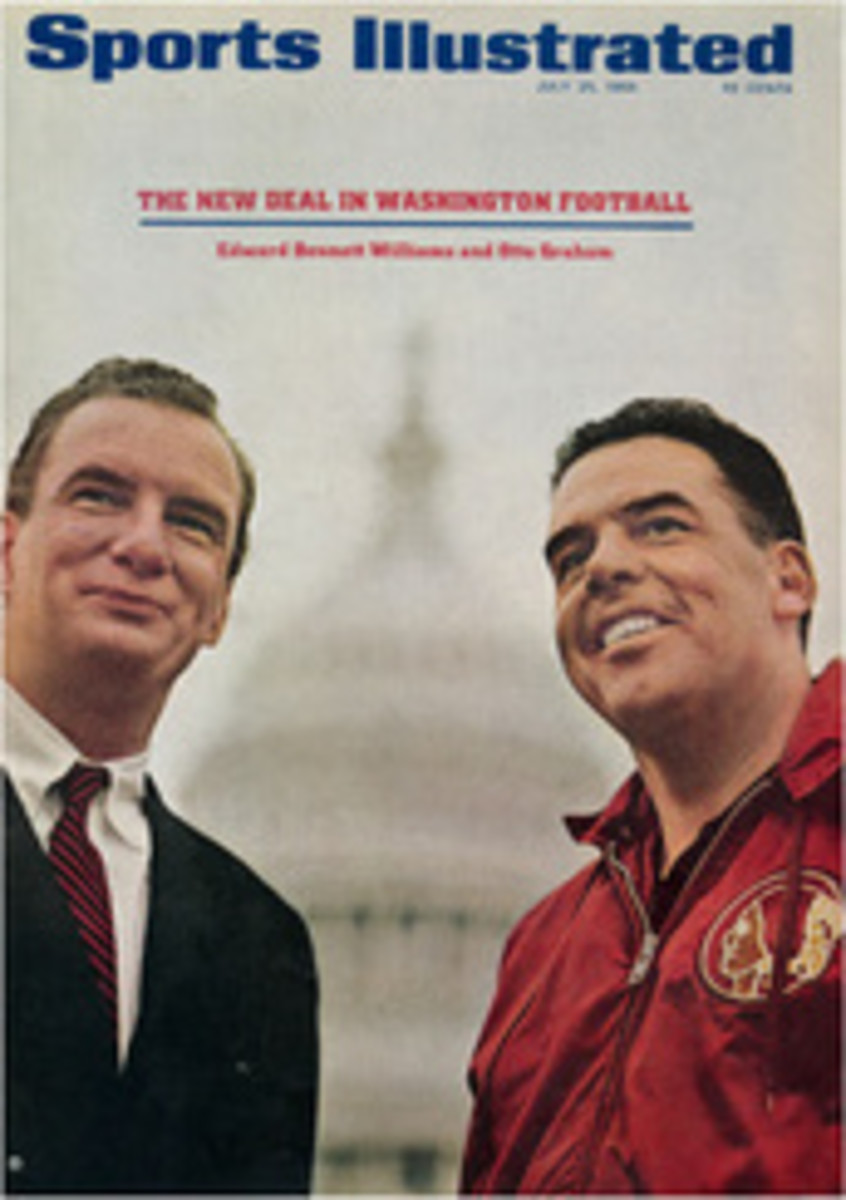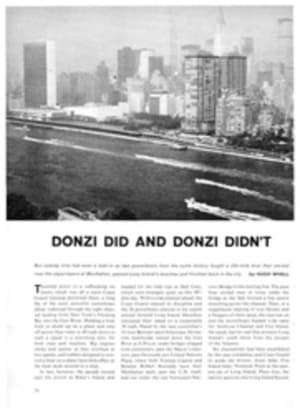
DONZI DID AND DONZI DIDN'T
Throttled down to a suffocating six knots, which was all a stern Coast Guard warning permitted them, a long file of the most powerful motorboats afloat wallowed through the tight channel leading from New York's Flushing Bay into the East River. Holding a boat built to climb up on a plane and take off across blue water at 60 mph down to such a speed is a punishing duty for both man and machine. Big engines choke and sputter as they overheat at low speeds, and rudders designed to control a boat on a plane have little effect as the boat skids around in a slop.
At last, however, the parade moved past the prison at Riker's Island and headed for the tidal rips at Hell Gate, which were strangely quiet on this 90° plus day. With a wide channel ahead, the Coast Guard relaxed its discipline and the 20 powerboats entered in the eighth annual Around Long Island Marathon increased their speed to a respectable 30 mph. Paced by the race committee's 31-foot Bertram sport fisherman, the marine motorcade roared down the East River at 8:30 a.m. under bridges clogged with commuters, past the Mayor's mansion, past the swank new United Nations Plaza, where both Truman Capote and Senator Robert Kennedy have their Manhattan pads, past the U.N. itself, and out under the vast Verrazano-Narrows Bridge to the starting line. The pace boat circled once or twice under the bridge as the fleet formed a line astern stretching across the channel. Then, in a magnificent clearing of iron throats and a Niagara of white spray, the race was on and the powerboats headed wide open for Ambrose Channel and Fire Island, the sandy barrier reef that protects Long Island's south shore from the ravages of the Atlantic.
Six checkpoints had been established by the race committee and Coast Guard to guide the drivers: Jones Inlet, Fire Island Inlet, Montauk Point at the eastern tip of Long Island, Plum Gut, the narrow gateway into Long Island Sound, Old Field Point and Lloyd Neck. The 250-mile course they punctuate is an almost perfect test of offshore racers. It offers plenty of distance, conditions that go from rough to calm and navigation problems tricky enough to plague the ablest. "You just can't build an ideal boat for this race," said Driver Allan Brown the night before. "If you build for speed alone, you suffer in the rough water. If you design for the rough water, you'll lose out in the calm stretches. And then there's the navigating...."
Brown himself was driving Broad Jumper, a 28-foot Donzi owned by New Yorker Bill Wishnick. Racked up against him were at least two other Donzis, one the 35-foot Maltese Magnum, owned and driven by swarthily handsome Don Aronow, who used to head the Donzi company, gave it his nickname and now serves as its adviser.
At the outset, however, Brown, who is Donzi's sales manager when he is ashore, expected that Broad Jumper's big competition would come not from the other Donzis but from the 28-foot Formula driven by Dick Finnerty and powered by twin 475-hp Chrysler hemi-head engines. Finnerty proved a threat all right, but not for long. About 15 miles out the belts came off his engines. The big Formula was left wallowing somewhere off Ambrose Lightship, and the race was between the two Donzis, Brown's and Aronow's.
"Except for about 15 miles around Montauk," said Brown later, "we ran side by side." By the time they reached Montauk the up to then relatively smooth Atlantic began to confront both boats with huge stubborn swells and heavy haze. Better suited to rough waters than Brown's faster Broad Jumper, Aronow's Maltese Magnum started to pull ahead. An added advantage for Aronow was the fact that his navigator, Bill Seidler, had fished the waters off Montauk for years and knows them better than a striped bass.
With Seidler to guide him, Aronow did his best to drop Brown astern in the haze, hoping his opponent would make a fatal navigational error once he was on his own. Otherwise, Aronow knew, Brown would catch up and kill him in the smooth waters of the Sound. But the big Maltese Magnum was just not able to escape, not even in the rough water, and the two boats approached Plum Gut still well in sight of each other. They burst through the Gut with their combined engines roaring in nerve-jangling unison.
Throughout the race there had been a considerable exchange of vituperative opinion between the friendly rivals aboard the two boats. The comments ranged from crude gestures to the heaving of beer cans and, once, even a Coke bottle. "Sometimes we got so we were swerving way off course charging each other," said Brown. Then Aronow's crewman, Jake Trotter, had an even better idea. "I saw Jake looking around in the cabin for the flare gun," said Aronow. "Then, good God, I could see him cocking it and aiming at Brownie. I told him not to. I told him he might get us disqualified." Fortunately for all hands, the gun was empty.
On flew the boats, past Stratford Shoals, past Execution Rocks and into the East River once again with their throttles wide open. Spectator craft at the finish line could see them coming out of the heat haze under the Throgs Neck Bridge so close together that they seemed to be a single spray-covered blip. Slapping along at better than 55 mph and separated by not more than 10 feet of water, they roared toward the finish line, bow to bow, gradually gaining separate identities. The sullen roar of their big Holman-Moody Ford engines rolled like a wave out ahead of them.
Now suddenly it became apparent that the Coast Guard, which had been so ubiquitous at the start, was nowhere to be seen at the finish. In its place was a motley fleet of outboard hot rodders and a tiny Penguin Class sailboat manned by two 12-year-olds. None of them seemed to know or care that two high-powered seagoing projectiles were aimed straight at them, and there seemed to be no officials of any kind around to tell them. Meanwhile, aboard the racing boats, Aronow and Brown were engaged in their own brand of confusion.
As the Donzis neared the finish neck and neck with no other competitor even close, Aronow, who, after all, invented Donzis, apparently decided it would be nice if they finished in a dead heat. He indicated his desire by wigwag signals to Donzi Executive Brown, who was leading. Brown apparently concurred and throttled Broad Jumper down a hair to bring the boats even. But Brown's navigator, a competitive type named Peter Rittmaster, was unaware of any finish line armistice arrangements. "Pete looked at the dials," said Brown later, "and when he saw the throttles weren't all the way down he had a fit. I thought for a minute he was going to commandeer the boat."
While Rittmaster and Brown explored their differences, the two boats went screaming for the line, scattering the spectator fleet like a pair of sharks flashing through a school of mullet. The line itself was somewhat vague, since the race committee had neglected to set out a buoy at one end of it. But at the other end, aboard the supposedly nonpartisan committee boat, Pete Rittmaster's girl friend, Gale Jacoby, herself a seasoned ocean racer (SI, Feb. 14), was jumping up and down screaming, "Come on, Brownie! Come on!" Either her efforts or those of her friend on Broad Jumper must have done the trick, for just before they reached the line, Brown's boat, at full throttle now, inched one second ahead of Aronow in an all-Donzi finish that was a nautical version of the Ford triumph at Le Mans. Gale Jacoby promptly burst into tears. "I've never won a race myself," she cried. "But I'm just as excited as if I had." It was one of the closest finishes in ocean powerboat racing and certainly the closest in the eight-year history of the Long Island Marathon.
"It was a textbook run," said Brown just before he accepted the huge Hennessey Trophy and the kiss from Gale Jacoby that went with it. "When we started out," he went on, moving his fingers to represent needles showing maximum performance, "the dial needles went wonk and they never moved again till we finished."
As for Don Aronow, the only trouble he had over the whole affair was getting to the race in the first place. Stranded in Miami with airline tickets rendered useless by the mechanics' strike, Aronow, who travels even faster on land than he docs on water, jumped into his Cadillac with Crewman Jake Trotter and headed for New York. He made it in 20 hours at an average speed of 70 mph. "How fast are we going, Don?" Jake asked once along the way. "About 65?" "Nope," said Aronow. "120." Jake said nothing, but there was a firm click as he tightened his safety belt.
After that, riding a boat around Long Island at 60 mph was little more than a breeze.
PHOTO

